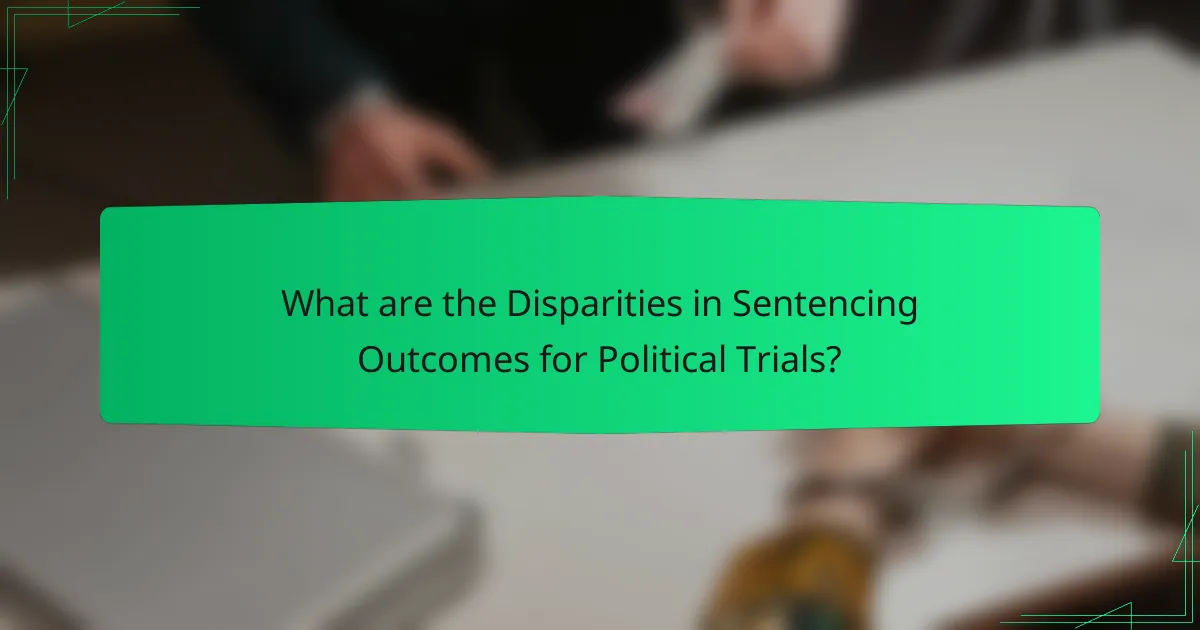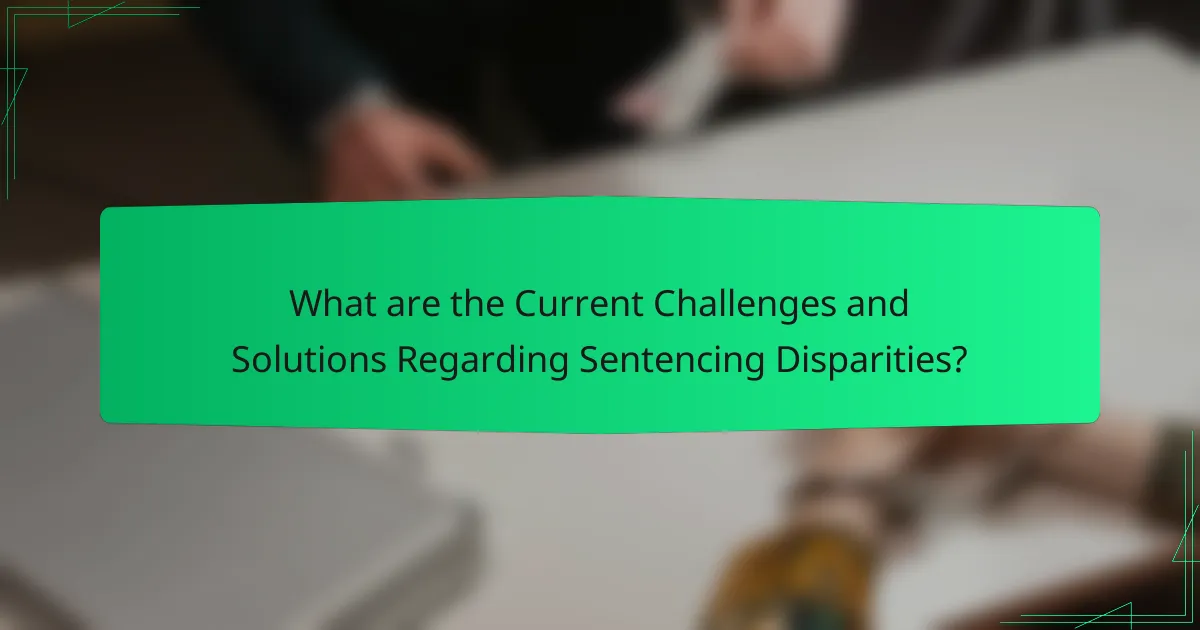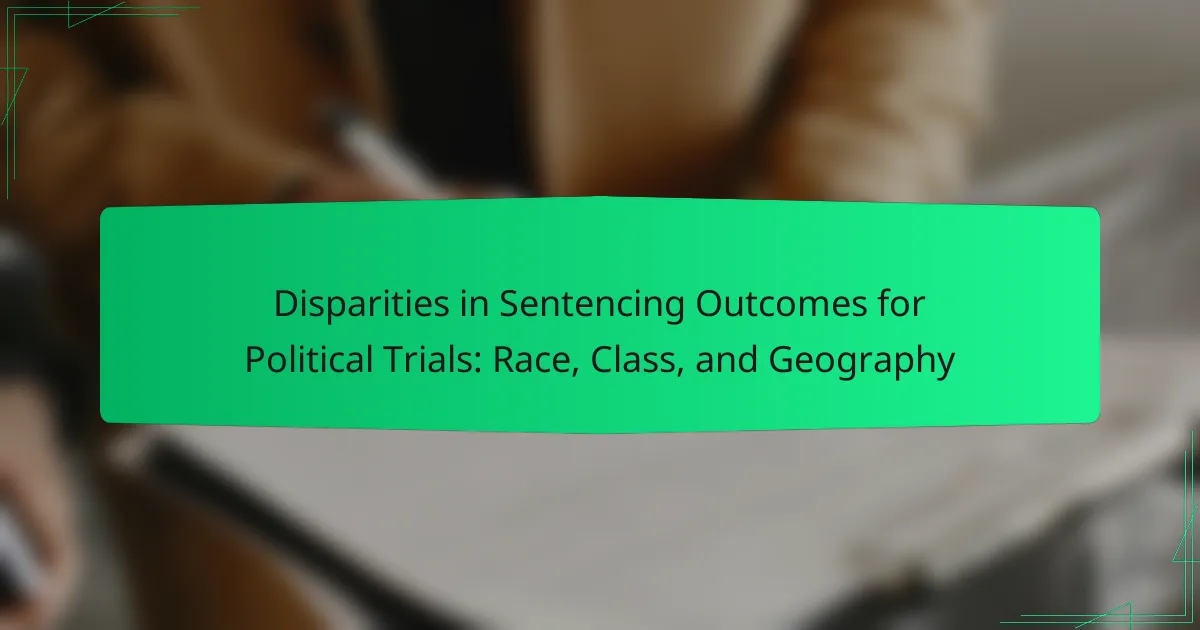Disparities in sentencing outcomes for political trials reveal significant systemic inequalities influenced by race, class, and geography. Minority groups often receive harsher penalties compared to white defendants, with political affiliation and geographic location further affecting sentencing severity. Historical contexts, such as the McCarthy era and the Civil Rights Movement, illustrate persistent biases in judicial processes. Current challenges include systemic bias, inconsistent legal application, and socio-economic factors impacting sentencing. Solutions proposed involve standardized sentencing guidelines, implicit bias training for judges, and increased transparency in sentencing data to address these disparities effectively.

What are the Disparities in Sentencing Outcomes for Political Trials?
Disparities in sentencing outcomes for political trials often reflect systemic inequalities. Factors such as race, class, and geography significantly influence these outcomes. Minority groups frequently receive harsher sentences compared to their white counterparts. Research indicates that political affiliation also plays a role in sentencing severity. For instance, individuals associated with marginalized political movements may face stiffer penalties. Geographic location contributes to variations in sentencing practices. Jurisdictions with more conservative leanings may impose stricter sentences on political dissenters. Studies show that socioeconomic status affects legal representation quality, impacting trial outcomes. Overall, these disparities highlight the intersection of social factors in the judicial process.
How do race, class, and geography influence sentencing outcomes?
Race, class, and geography significantly influence sentencing outcomes. Racial disparities exist in sentencing, with studies showing that people of color often receive harsher sentences compared to white defendants. For instance, a 2017 report by the U.S. Sentencing Commission found that Black male offenders received sentences that were, on average, 19.1% longer than those of white male offenders for similar crimes. Class also plays a critical role; individuals from lower socioeconomic backgrounds may lack access to quality legal representation, leading to harsher sentences. Research indicates that public defenders often have heavier caseloads and fewer resources than private attorneys, affecting case outcomes. Geography further impacts sentencing, as different jurisdictions have varying laws and sentencing practices. For example, some states have mandatory minimum sentences that disproportionately affect marginalized communities. Overall, these factors create a complex interplay that results in unequal sentencing outcomes across different demographic groups.
What specific factors contribute to racial disparities in sentencing?
Racial disparities in sentencing are influenced by several specific factors. These include systemic biases within the criminal justice system. Studies show that individuals from minority backgrounds often receive harsher sentences compared to their white counterparts. The discretion exercised by judges can lead to unequal treatment based on race. Additionally, socio-economic status plays a significant role in sentencing outcomes. Research indicates that defendants with limited resources may not access quality legal representation. This disparity in legal support can affect the severity of sentences. Furthermore, the impact of prior criminal history is often interpreted differently across racial lines. Statistical analysis reveals that similar offenses can result in varying sentences based on the race of the offender. These factors collectively contribute to the ongoing issue of racial disparities in sentencing.
How does socioeconomic status impact sentencing decisions?
Socioeconomic status significantly impacts sentencing decisions. Individuals from lower socioeconomic backgrounds often receive harsher sentences compared to those from higher statuses. Research indicates that judges may unconsciously associate wealth with positive traits, leading to more lenient sentences for affluent defendants. A study published in the Journal of Criminal Justice found that defendants with higher income levels were 20% less likely to receive prison time. Conversely, defendants from lower-income backgrounds face systemic biases that can result in longer sentences. This disparity reflects broader societal inequalities and influences the legal outcomes for individuals based on their economic status.
In what ways does geographic location affect trial outcomes?
Geographic location significantly affects trial outcomes through variations in legal standards, jury demographics, and local political climates. Different jurisdictions may have distinct laws that influence sentencing, such as mandatory minimums or sentencing guidelines. For instance, a study by the Brennan Center for Justice found that sentencing outcomes can vary widely between states due to these legal differences. Jury demographics also play a crucial role; diverse juries may lead to different perceptions of guilt or innocence. Research has shown that predominantly white juries may exhibit bias against defendants of color. Additionally, local political climates can impact prosecutorial discretion and the severity of charges brought against defendants. Areas with more progressive political environments may result in more lenient outcomes compared to conservative regions. These factors collectively illustrate how geographic location can lead to disparities in trial outcomes.
Why do these disparities matter in the context of political trials?
Disparities in sentencing outcomes for political trials matter because they highlight systemic inequalities. These inequalities can undermine public trust in the judicial system. For instance, studies show that racial minorities often receive harsher sentences compared to their white counterparts for similar offenses. Additionally, socioeconomic status influences sentencing, with lower-income individuals facing more severe penalties. Geographic location also plays a role, as different jurisdictions may have varying sentencing practices. These factors collectively contribute to perceptions of injustice and bias in political trials. Addressing these disparities is crucial for ensuring fairness and equality under the law.
What implications do sentencing disparities have on public trust in the legal system?
Sentencing disparities significantly undermine public trust in the legal system. When individuals perceive that similar offenses receive different sentences based on race, class, or geography, they question the fairness of judicial processes. Research shows that perceived inequities can lead to disillusionment with legal institutions. A study by the Brennan Center for Justice found that 75% of Americans believe the justice system is biased. This perception can erode community cooperation with law enforcement and discourage individuals from seeking legal recourse. Ultimately, widespread belief in sentencing disparities can diminish the legitimacy of the legal system in the eyes of the public.
How do these disparities reflect broader societal inequalities?
Disparities in sentencing outcomes for political trials reflect broader societal inequalities by highlighting systemic biases. These biases often stem from race, class, and geographic factors. For instance, studies show that marginalized communities face harsher penalties compared to their more privileged counterparts. According to the Vera Institute of Justice, Black defendants receive longer sentences than white defendants for similar offenses. Additionally, socioeconomic status influences access to quality legal representation, affecting trial outcomes. Geographic disparities also emerge, as urban areas often experience different judicial practices than rural ones. These patterns reveal how societal structures perpetuate inequality through the legal system.

What are the Historical Contexts of Disparities in Political Trials?
Disparities in political trials have historical contexts rooted in systemic inequalities. These inequalities often reflect broader societal issues such as race, class, and geography. For instance, during the McCarthy era, political trials disproportionately targeted individuals based on their political affiliations and backgrounds. The Civil Rights Movement also highlighted disparities, as activists faced harsher legal repercussions compared to their white counterparts.
Historical evidence shows that minority groups have consistently experienced bias in judicial processes. The War on Drugs further exemplified this, with racial minorities facing more severe sentencing outcomes. Additionally, geographic disparities exist, where rural defendants may encounter less favorable legal representation compared to urban counterparts.
These contexts illustrate how political trials have been influenced by societal power dynamics, leading to unequal treatment under the law. Historical records confirm that these disparities persist across various political climates and legal systems.
How have historical events shaped current sentencing practices?
Historical events have significantly influenced current sentencing practices. The abolition of slavery in the 19th century led to the establishment of laws that disproportionately affected African Americans. The Civil Rights Movement further highlighted racial disparities in sentencing. Landmark cases, such as Brown v. Board of Education, prompted legal reforms aimed at reducing inequality. The War on Drugs in the 1980s introduced mandatory minimum sentences, exacerbating racial and socioeconomic disparities. Additionally, historical injustices have led to ongoing debates about restorative justice versus punitive measures. These events have shaped public perceptions and policies surrounding sentencing today.
What role did landmark cases play in establishing sentencing norms?
Landmark cases play a crucial role in establishing sentencing norms by setting legal precedents. These cases influence the interpretation of laws related to sentencing. For example, the U.S. Supreme Court case, Furman v. Georgia (1972), addressed the arbitrary nature of the death penalty. This ruling led many states to reform their sentencing practices to ensure consistency and fairness. Landmark cases often highlight disparities in sentencing outcomes based on race, class, and geography. They prompt legislative changes to address these inequalities. Overall, landmark cases shape the legal landscape of sentencing norms and guide judicial discretion.
How have changes in laws influenced sentencing outcomes over time?
Changes in laws have significantly influenced sentencing outcomes over time. Legislative reforms have often aimed to address disparities in the justice system. For instance, the introduction of mandatory minimum sentences in the 1980s led to harsher penalties for certain offenses. This change disproportionately affected marginalized groups, exacerbating racial and socioeconomic disparities. Conversely, recent reforms aimed at reducing mass incarceration have begun to lessen these disparities. States have enacted laws to allow for more discretion in sentencing. Such changes have resulted in reduced sentences for non-violent offenses. Research indicates that these shifts have led to a decline in prison populations. Overall, evolving laws continue to shape the landscape of sentencing outcomes.
What are the trends in sentencing disparities across different regions?
Sentencing disparities across different regions reflect significant variations in judicial outcomes. These disparities often correlate with factors such as race, socioeconomic status, and local laws. For instance, studies show that individuals from marginalized communities frequently receive harsher sentences compared to their counterparts. Research by the U.S. Sentencing Commission indicates that Black defendants often face longer sentences than white defendants for similar offenses. Additionally, geographical differences can impact sentencing, with urban areas typically exhibiting more lenient sentencing patterns compared to rural regions. This trend highlights the influence of local legal practices and community standards on judicial decisions. Overall, the data underscores a persistent inequity in sentencing that varies by region, race, and class.
How do urban and rural areas differ in sentencing outcomes?
Urban and rural areas differ significantly in sentencing outcomes. Urban areas often experience harsher sentencing due to higher crime rates and more aggressive prosecution strategies. In contrast, rural areas may impose lighter sentences influenced by community ties and local norms. Studies indicate that urban defendants face longer prison terms compared to their rural counterparts. For example, a report by the U.S. Sentencing Commission shows that urban offenders receive sentences that are, on average, 20% longer. Additionally, rural judges may prioritize rehabilitation over punishment, resulting in more lenient sentences. This disparity highlights the impact of geographical context on judicial outcomes.
What patterns can be observed in different states or countries?
Patterns in sentencing outcomes for political trials vary significantly across states and countries. Factors such as race, class, and geography influence these disparities. For instance, in the United States, minority defendants often receive harsher sentences compared to their white counterparts. Research by the Sentencing Project indicates that Black individuals are sentenced to longer prison terms than white individuals for similar offenses.
Additionally, geographical differences affect sentencing. Southern states tend to impose more severe penalties in political trials than Northern states. A study published in the Journal of Criminal Justice found that political defendants in states with a history of racial tension face steeper sentences.
Internationally, countries with authoritarian regimes frequently exhibit biased sentencing practices. In such nations, dissenters may face disproportionately harsh penalties. For example, reports from Human Rights Watch highlight that political prisoners in countries like Belarus receive lengthy sentences for minor infractions.
Overall, the interplay of race, class, and geography creates distinct sentencing patterns in political trials.

What are the Current Challenges and Solutions Regarding Sentencing Disparities?
Current challenges regarding sentencing disparities include systemic bias, lack of standardized guidelines, and socio-economic influences. Systemic bias often leads to harsher sentences for marginalized groups. Research indicates that racial minorities face longer sentences compared to their white counterparts for similar offenses. Additionally, inconsistent application of laws across jurisdictions creates disparities. Socio-economic factors, such as poverty, can also affect sentencing outcomes.
Solutions to these challenges involve implementing standardized sentencing guidelines. These guidelines can help ensure more uniformity in sentencing decisions. Training for judges on implicit bias is also crucial. This can mitigate the impact of personal biases on sentencing. Furthermore, increasing transparency in sentencing data can promote accountability. Public access to sentencing statistics can help identify and address disparities effectively.
What challenges do legal professionals face in addressing these disparities?
Legal professionals face significant challenges in addressing disparities in sentencing outcomes for political trials. One major challenge is the systemic bias present in the judicial system. Studies indicate that race, class, and geography influence sentencing decisions, leading to unequal outcomes. Legal professionals must navigate these biases while advocating for fair treatment. Additionally, a lack of resources often hampers their ability to challenge disparities effectively. Limited access to expert witnesses or data can weaken their arguments. Furthermore, legal professionals may encounter resistance from the judiciary or political entities. This resistance can obstruct efforts to reform sentencing practices. Overall, these challenges complicate the pursuit of equity in the legal system.
How does bias in the judicial system contribute to sentencing inequalities?
Bias in the judicial system significantly contributes to sentencing inequalities. This bias can manifest in various forms, including racial, socioeconomic, and geographic disparities. Research indicates that judges may impose harsher sentences based on the race of the defendant. For instance, a study by the United States Sentencing Commission found that Black male offenders received sentences that were, on average, 19.1% longer than those of white male offenders for similar crimes. Additionally, socioeconomic status can influence judicial decisions, with lower-income individuals often receiving stiffer penalties. Geographic location also plays a role; sentencing practices can vary widely across jurisdictions, leading to inconsistent outcomes. These biases create a landscape where certain groups face disproportionate sentencing, undermining the principle of equal justice under the law.
What are the limitations of current policies aimed at reducing disparities?
Current policies aimed at reducing disparities often lack comprehensive data analysis. Many policies do not address systemic biases within the judicial system. They frequently overlook the intersectionality of race, class, and geography. Additionally, these policies may be inadequately funded, limiting their effectiveness. Stakeholders often face challenges in implementation due to bureaucratic hurdles. Furthermore, there is a lack of accountability measures for policy outcomes. Research indicates that without robust evaluation, policies fail to adapt to changing needs. This results in persistent disparities in sentencing outcomes.
What strategies can be implemented to mitigate sentencing disparities?
Implementing standardized sentencing guidelines can mitigate sentencing disparities. These guidelines create a uniform framework for judges to follow. Consistent application reduces the influence of personal biases. Training programs for judges on implicit bias can further address disparities. Research indicates that education on bias can improve decision-making. Additionally, increasing transparency in sentencing decisions promotes accountability. Public access to sentencing data allows for scrutiny and evaluation. Establishing oversight committees can help monitor sentencing practices. These strategies collectively work towards fairer sentencing outcomes.
How can education and training improve awareness of sentencing biases?
Education and training can enhance awareness of sentencing biases by providing critical knowledge about systemic inequalities. Training programs can address the historical context of racial and socioeconomic disparities in the justice system. Workshops can educate legal professionals on implicit biases that affect decision-making. Research indicates that informed individuals are more likely to recognize and challenge biases in sentencing. For example, studies show that training reduces bias in judicial decisions. Additionally, ongoing education fosters a culture of accountability and reflection. This continuous learning process helps to identify and mitigate biases in real-time. Ultimately, education and training create a more equitable justice system.
What role does community engagement play in reforming sentencing practices?
Community engagement plays a crucial role in reforming sentencing practices. It fosters collaboration between legal systems and the communities they serve. Engaged communities can provide valuable insights into the social dynamics affecting crime and punishment. This input can lead to more culturally informed and equitable sentencing decisions. Research indicates that jurisdictions with active community involvement often see reduced recidivism rates. For example, community-based programs have shown success in addressing underlying issues such as poverty and education. Such initiatives can promote restorative justice, focusing on rehabilitation rather than punishment. Additionally, community engagement can enhance transparency and accountability in the judicial process. This, in turn, builds trust between marginalized communities and the legal system.
What best practices can be adopted to ensure fair sentencing in political trials?
Implementing transparent legal processes is essential for fair sentencing in political trials. Ensuring that all proceedings are open to public scrutiny fosters accountability. Utilizing independent judges can mitigate biases that may influence sentencing. Establishing clear legal standards for sentencing helps maintain consistency across cases. Providing access to legal representation for defendants ensures their rights are protected. Conducting regular training for judges on bias and discrimination can improve decision-making. Finally, involving a diverse jury can reflect broader societal perspectives and reduce systemic disparities. These practices collectively contribute to a more equitable judicial process in political trials.
How can transparency in sentencing decisions enhance accountability?
Transparency in sentencing decisions enhances accountability by allowing public scrutiny of judicial actions. When sentencing information is accessible, it fosters trust in the legal system. This openness can deter biased or unjust sentencing practices. Studies show that transparency reduces disparities in sentencing outcomes. For example, jurisdictions with transparent practices report lower rates of racial or class-based discrepancies. Public access to sentencing data encourages judges to adhere to established guidelines. It also enables stakeholders to hold the judiciary accountable for their decisions. Overall, transparency serves as a check against arbitrary or discriminatory sentencing.
What measures can be taken to promote equitable treatment in the legal system?
Implementing measures such as bias training for legal professionals can promote equitable treatment in the legal system. Regular training can help identify and mitigate unconscious biases that affect decision-making. Establishing clear guidelines for sentencing can ensure consistency across cases. Data collection on sentencing outcomes can reveal disparities based on race, class, and geography. Public access to this data fosters accountability and transparency. Community engagement initiatives can educate the public about their rights and the legal process. Legal aid programs can provide support to underrepresented groups, ensuring they have access to fair representation. Finally, promoting diversity within legal institutions can lead to more equitable perspectives in legal proceedings.
Disparities in sentencing outcomes for political trials emerge as a critical issue influenced by race, class, and geography. The article examines how these factors contribute to systemic inequalities, revealing that minority groups often face harsher penalties compared to their white counterparts, while socioeconomic status affects legal representation quality. Geographic location also plays a significant role, with varying sentencing practices across jurisdictions. Historical contexts further illustrate how past injustices shape current sentencing norms and highlight the need for reform to ensure fairness and accountability in the judicial system.


